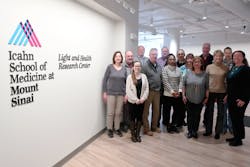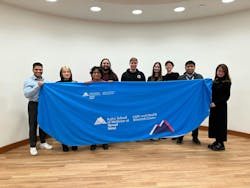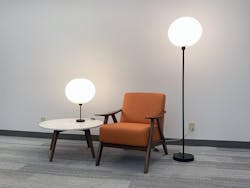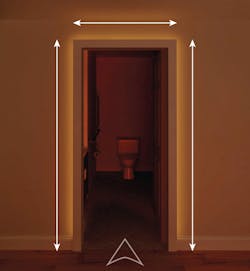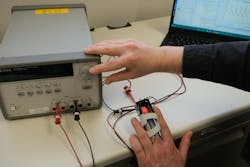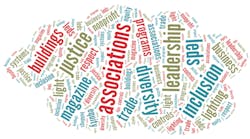EDITED BY CARRIE MEADOWS
The Mount Sinai Light and Health Research Center, Department of Population Health Science and Policy, has continued to build on the foundational work in lighting for health initially undertaken at Rensselaer Polytechnic Institute (RPI). Originally formed at RPI in 1988 as the Lighting Research Center, the Mount Sinai Light and Health Research Center (LHRC) was created in 2020 to apply the science of light to improve health outcomes.
Housed at the Department of Population Health Science and Policy at the Icahn School of Medicine at Mount Sinai, a team of highly skilled researchers, educators, and designers works out of two locations: Mount Sinai’s main campus in New York City and a state-of-the-art research center in Menands, New York. The LHRC’s Menands facilities include a fully equipped photometry laboratory, human-subjects research capabilities, a design and application workshop, and conference space.
Led by LHRC director and Mount Sinai professor of light and health research Mariana Figueiro and professor Mark Rea, the LHRC team works with partners from industry, government, and academia to conduct research aimed at better understanding light’s real-world applications, including human health, transportation safety, plant health, and energy efficiency. LHRC leadership is further supported by Kevin Brenner, engineering program director; Jennifer Brons, research program director; and program directors John Bullough and Daniel Frering.
Its past sponsors showcase the diversity of the LHRC’s research. Such organizations include the National Institutes of Health, the U.S. Department of State, the General Services Administration, the U.S. Department of Agriculture’s National Institute of Food and Agriculture, and the Swedish Energy Agency.
Mission, in layperson terms: Advancing the wellbeing of people and the planet through the science of light.
What we are known for: Our three decades of leadership in the lighting industry and for advancing the science of light and health, specifically through education, pioneering translational research, and reliable third-party review of lighting technology. Our staff, led by Mariana Figueiro, is unique in bringing together people who not only have expertise in basic biophysical and psychophysical research and familiarity with lighting technology and applications, but who can also tie them together.
What people don’t know about us: Our productivity level is evident in countless papers, lectures, proposals, and sponsorships across diverse areas, including — but not limited to — lighting, sleep and circadian rhythms; lighting and falls; lighting and energy efficiency; light pollution control; discomfort glare; germicidal ultraviolet (GUV); color rendering; mesopic vision; agriculture pathogen control; and headlights and traffic safety. Since our work touches these different areas, people who know us for just one of these areas may have no idea about the other areas we work in.
Summarize your group culture: Multidisciplinary, collaborative, and diverse. We pride ourselves on our flat structure, where everyone across the team is on a first-name basis. Most importantly, we all like to learn, and for that reason, we don’t tend to repeat the same studies. Instead, we try to work in new areas where we can not only contribute, but also learn new things — and under Mariana’s leadership, we’ve been able to collaborate both within Mount Sinai and outside of it remarkably well.
First commission (product, project, or study): The current iteration of the LHRC was formed at Mount Sinai in 2020, but most of our research team started out as the Lighting Research Center at RPI. At RPI, we were renowned for our research on lighting energy efficiency, human factors, and laboratory and field testing of lighting technologies. As part of her thesis at RPI, Mariana authored the first publication showing the human circadian system exhibited subadditivity, demonstrating how the neurons that partially form color perception play a role in the circadian system’s light sensitivity. This, among other projects, made us a world leader in lighting research.
Additionally, Mark Rea was the editor-in-chief of two editions of the Illuminating Engineering Society (IES) Handbook, which is the industry standard for science and practice of illuminating engineering. (The IES Handbook is admissible in court as evidence of industry-standard practice, and Mark is periodically called upon as an expert witness.)
Some of our first projects after our move to Mount Sinai included the impact of a tailored lighting intervention designed to improve sleep, mood, and behavior in Alzheimer’s disease and mild cognitive impairment patients; the development of a circadian-effective luminaire in partnership with Lund University in Sweden; a project investigating the impact of light pollution on health, funded by the European Union; and a study on the long-term brightness performance of exit signs using LED light sources, funded by the Jim McClung Foundation.
Favorite product/project by our company and why: We work on many kinds of projects, so naturally the answers vary among our team. One favorite project includes a 2014 National Institute on Aging (NIA)–funded study investigating the effects of lighting intervention on sleep, depression, and agitation in people with Alzheimer’s disease and related dementia living in long-term care facilities.
We love our field studies in general, mostly because of the feedback from our participants — some of them have said that they like their health improvements with our lighting interventions so much, they wish they could keep the lights after the study!
Another favorite is a study we completed in 2023 where we partnered with the Emergency Responder Safety Institute. We investigated the impacts of reflective markings for emergency vehicles on drivers’ ability to see first responders working just outside their vehicles. We found that if the markings are too bright (which they often are), the first responders are at greater risk of injury or death because drivers simply can’t see them well — and we came up with recommendations for the maximum brightness level accordingly.
Another timely project we’re working on is an experiment about pulse oximetry, specifically the role of LED light sources in pulse oximeters as the likely cause of systematic bias in readings for people with darker skin pigmentation. We found that commercially available pulse oximeters may actually overestimate the blood oxygen saturation levels of people with darker skin, therefore putting them in danger of not getting the care they need. Our findings from these experiments are being published in the British Journal of Anesthesia.
What are you currently working on? We’re working on several projects aiming to improve older adults’ quality of life using lighting. The team in NYC is busy recruiting for our clinical trials, including lighting for improving sleep in Alzheimer’s disease, mild cognitive impairment, and Parkinson’s disease patients as well as cancer patients undergoing multiple myeloma transplant.
Research program director Jennifer Brons is looking into lighting to reduce falls when seniors get up to use the bathroom at night. At RPI, we showed that luminous lines that frame a door at night can help older adults in that respect. Now, our field demonstrations are installing linear nightlights around the doorframes of bathroom doors, providing a soft amber glow at night that is hardly visible by day. We’re installing specification-grade doorframe lighting in eight patient rooms at Mount Sinai Hospital, and field studies are starting soon at senior apartments in North Carolina.
Program director John Bullough is working on an NIH-funded project to assist Blue Iris Labs in developing a new device to measure personal light-dark exposures. This will help older adults get light and dark exposure at appropriate times and in appropriate amounts to improve their circadian entrainment.
A lighting trend, design, or scientific concept to leave behind: Bare lamps in decorative luminaires; we need glare control, especially as we age. It’s fine to have a little sparkle from your electric lighting, but when illuminating spaces, please hide the source!
A tool or product you want to invent: We are currently working with the American Lighting Association (ALA) to encourage the development of residential lighting that is pre-designed to provide circadian stimulation, without being glary or using excess energy. We’d also love to invent a bias-free pulse oximeter.
Technology, (third-party) product, and/or designer you admire: In terms of technology, we love white LEDs and UV LEDs. We also admire the sense of wonder created by lighting “experiences” in the art world, especially Moment Factory of Montreal, Canada.
Favorite lighting/engineering rule, standard, or equation: Light the walls, hide the source; the “moth effect” — people notice the brightest thing in their environment; and get bright days, dim evenings, and dark nights for better sleep.
Summarize your environmental, sustainability, and governance (ESG) initiatives: While focusing on light impacts on health, we balance energy efficiency, comfort, and practicality and make sure to test and publish the performance of energy-efficient technologies. For example, sometimes the most practical solution for circadian stimulation is rearranging the furniture to embrace daylight.
Advice to anyone interested in entering the lighting industry or research sector: Our industry is great for people who enjoy the balance of both aesthetics and technical analysis. We may not be the “stars” of the architectural show, but we make the stars look fabulous! Also, don’t think of yourself as a specialist — be flexible, be willing to learn, and, if you’re working in lighting, be willing to work some nights.
Associations, committees, nonprofits, or mentorship programs that your organization participates in: The LHRC is associated with the Alzheimer’s Association, National Institutes of Health, the Society of Automotive Engineers, General Services Administration, and many other partner organizations. Some of our colleagues also individually participate in the IES, the International Association of Lighting Designers (IALD), the Lighting Certified (LC) program from the National Council on Qualifications for the Lighting Professions (NCQLP), the Transportation Research Board, the Academic Advisory Council for Signage Research and Education, the Sleep Research Society, and the Society for Research on Biological Rhythms.
CARRIE MEADOWS is editor-in-chief of LEDs Magazine, with 20-plus years’ experience in business-to-business publishing across technology markets including solid-state technology manufacturing, fiberoptic communications, machine vision, lasers and photonics, and LEDs and lighting.
*Updated March 28, 2024 10:20 AM for team image caption corrections. LEDs Magazine regrets the error.
Follow our LinkedIn page for our latest news updates, contributed articles, and commentary, and our Facebook page for events announcements and more. You can also find us on the X platform.
